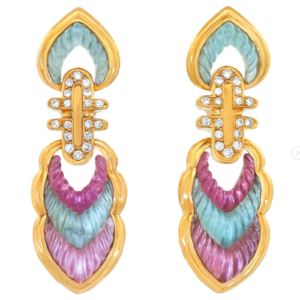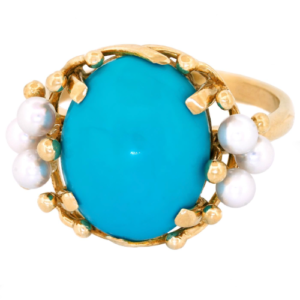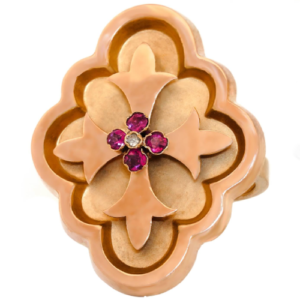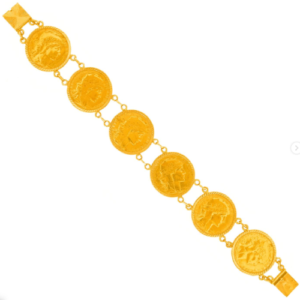Episode 203
What you’ll learn in this episode:
- How to know when to walk away from a purchase, and how to trust your intuition when buying
- Why you should always ask for a detailed receipt, even if it feels awkward
- Commonly misunderstood phrases dealers may use to confuse buyers
- How Jeff does due diligence before making a purchase
- How to navigate the many platforms where you can purchase jewelry today
About Jeff Russak
Jeff Russak is principal of Lawrence Jeffrey Estate Jewelers. Jeff’s expertise in antique and 20th century jewelry combined with an uncompromising attitude toward quality, condition, and style directs the acquisition process. His proficiency in signed pieces and hallmarks is especially useful in identifying and dating each piece. In demand as a speaker on antique jewelry at museums and shows, he also volunteers as a guest appraiser for charity.
Additional Resources:
Photos (From LJ’s Instagram):
Soooo eighties, so valley girl Carved Aquamarine, Tourmaline, and Diamond Earrings… the look is … easy breezy California!

Organo-Chic Opal Ring, Sixties German Post Modern Chic…oceanic, galactic, mythic… handmade, 18k and very very heavy

Mings of Hawaii Sixties Turquoise and Pearl Ring…effortless everyday chic

Gothic pop art ring American sixties style! Think posh motorcycle jewelry on the cover of Vogue, authentic American cool!

French Art Deco Gold Coin Bracelet. The 20 Franc coins make it extra special

Transcript:
When it comes to buying jewelry, nothing is more important than trust. That’s why Jeff Russak, principal at Lawrence Jeffrey Estate Jewelers, won’t hesitate to leave a purchase behind if his inner voice tells him something is wrong. He joined the Jewelry Journey Podcast to talk about how he vets his purchases and the dealers he works with; what red flags buyers should watch out for; and why a receipt is more powerful than you might think. Read the episode transcript here.
Sharon: Hello, everyone. Welcome to the Jewelry Journey Podcast. This is the second part of a two-part episode. If you haven’t heard part one, please head to TheJewelryJourney.com.
Today, my guest is Jeff Russak, one of the principals of Lawrence Jeffrey. They are estate dealers located in Litchfield, Connecticut. Jeff has had decades of experience buying and selling. He’s also extremely knowledgeable about estate jewelry. Welcome back.
What are the mistakes you see people make, whether in the receipt, in the returns or not asking the right questions? What are the mistakes you see?
Jeff: The mistakes I see boil down to trusting the wrong person. There you are, and they’re showing you a five-carat ruby. It’s fire-engine red and pretty clear. It’s in a nice ring, and it’s $12,000 to $14,000. I can think of a half dozen booths I’ve seen at shows that had jewelry like this. Well, it’s a good deal, and they’re going to tell you it’s a good deal. They’re going to tell you how beautiful it is, but somewhere your brain must be going, “I’m a little worried.” If you’re a little worried, stop. I can tell you that those rubies were glass-filled. Of course, they looked good. Were they rubies? The GIA would call them a red, man-made product rather than a ruby. I’ve gotten a report on such a stone, and that’s what they said.
I think you have to listen to your voice. The less you know, the more wary you need to be, and the more questions you need to ask. The more questions you ask, eventually you’re going to hear things that are going to lead you to either trust and buy or not trust and not buy. If I were a neophyte, I would be like, “Wow, that’s a really good price. That’s so much less than I’ve seen for similar pieces. Is the stone natural?” If they say, “Oh yes, this is an all-natural ruby,” I would say, “Will you write that on my receipt?” Then you have recourse. Now we’re getting into federal law.
Again, we’re talking about someone who doesn’t know. You have to ask questions to try and get a sense. It’s like questioning your six-year-old who’s definitely got cupcake crumbs on his fingers. You know something has happened. You’re not quite sure what, but you’re pretty sure. You want to give him a chance. “So, what have you been up to?” “Oh, nothing.” “What’s on your fingers?” They’re going to look at their fingers. “Nothing but these crumbs.” “Crumbs, really?” So, you begin to get an idea.
The truth is there’s no silver bullet for solving these issues. I tell my clients to decide what fun money is to you. For some people, that’s $100. For other people, that’s $10,000. If you don’t want to become more expert in something you want to buy a lot of, if you’re going to spend more than fun money, ask an expert. Bring someone in who’s knowledgeable, who’s an expert, and take it from there. I do that too. I’m pretty expert in a lot of stuff. When I buy a very high-end sapphire, I have someone out on the West Coast who is strictly an expert on sapphire. I will often send it to that person to have it evaluated in much greater detail than a lab report. I will speak with them, and they will walk me through tracing all those factors in the marketplace and how they relate to establish what a wholesale price for it would be, and even sometimes what a retail price would be. A small difference in color in a five-carat stone could be a $10,000 to $20,000 difference at retail.
Sharon: That’s certainly true. Can you look at a piece of gold and tell who the designer is or where it’s from?
Jeff: The first thing I do is look for the hallmarks. I’m deft with reading hallmarks, and if I don’t know—just this morning, I was taking a picture of a hallmark I couldn’t find anywhere. Our shop has a library off the main floor, and the walls are covered with books on all the various designers, on gemology, on the history of jewelry. Then there are cases, which are closed, and they’re filled with catalogues, every Tiffany catalogue from 1951. We have probably 60 or 70 Cartier catalogues. We have primary reference material we look at and use, but the short answer is about a third of the time, I can look at something and tell you who made it. But until I look at those hallmarks, it’s just a really well-informed guess.
Sharon: Can you tell the age of something? If you don’t know who made it, can you tell the age just by looking?
Jeff: Yes, by examining the piece and taking cues from both the aesthetic choices the goldsmith made, but also from the resources the goldsmith had when they were doing the fabrication. That usually is what tells me when something was made. The resources often dictate the mechanical style. For instance, the French often prefer not to physically join pieces in necklaces. They have a particular way of hinging them. It’s sort of a pin with a mushroom cap. When you see that, you almost always know that’s a French piece or it was made by someone who studied in France. If it’s a Genevan piece, well, the Genevans often studied across the border. There are a lot of clues. It just takes time to learn them.
Sharon: The people who work for you or with you, what do you suggest they learn? Do they follow you around, or do you show them each piece?
Jeff: I have a really knowledgeable staff. They know a lot. Truthfully, I tell them all the time that they know a lot more than they think. They get to a certain point and I stop telling them; I just ask. In the beginning, though, they’ll hesitate. They’ll say something and it’s almost always right. They have good instincts. When they’ve handled enough pieces, when we’ve pulled the books off the shelf—like when I look at Georgian pieces, I don’t just go, “Oh, this George III,” or “Oh, this is George IV,” or “This is early Victorian.” They look different aesthetically in many cases, but the way the mountings are made, for instance, changes in subtle ways over a period of time. So, I’ll go back to a reference book, and I’ll pull out a dozen pictures from each period, say from 1740 to 1780 and then 1780 to 1800, and try and make sure to narrow it down. Some people have that in their heads. That one still hasn’t stuck for me, so I always look it up to make sure.
And I have a photo repository. There are many museums that allow you to take photographs. I have extensive photographs of pieces from the Treasury in Vienna because they allow photographs. I believe the British Museum has a vast collection—I don’t believe; I know they have a vast collection of Victorian. They allow photographs, whereas the V&A, I don’t think they do; I’m trying to remember. So, we have those resources as well. We’re always trying to learn, and we take staff trips to museums. I’m hoping to take the staff on a museum tour, maybe in London at some point because there’s so much to learn there. Every time I go, it reinforces what I’ve seen before.
Sharon: Are there tours? I’m asking for a personal reason. Are there tours like you’re talking about?
Jeff: I think there are some jewelry tours. I want to say maybe get involved with Jewelry Week, the folks who run that. I don’t know of any. We would just go on our own. I know where to go and what to look at and which dealers to visit, the rock stars of our world.
Recently the Vegas Show went on, which is a dealer-only show. I was standing in a taxi line with my creative director, and we just struck up a conversation with one of the Heyman brothers from Oscar Heyman. I had no idea who he was, and we’re just talking about stuff. I didn’t even know he was in the jewelry world. Then he said something, and I was like, “Oh, you’re at one of the shows. What do you do? Who are you with?” He said, “I’m with Oscar Heyman. I’m such-and-such Heyman,” and I said, “Oh, wow! We love your work so much. We follow you. We look at your work. You have such an amazing reputation.” They’re the nicest people. He was so lovely. He looks around like he’s looking for somebody and says, “Did my mother send you?”
There’s a group of people who are fantastically honest. I would recommend anyone to buy their jewelry, to deal with them, to use them as a resource if you have a Heyman piece. You can get in touch with them, and they will help you. They’re really an example of the absolute pinnacle of an exemplary firm, and arguably maybe the most important American firm today.
Sharon: I’m surprised to hear you say that you go from high to low or low to high in terms of looking at jewelry.
Jeff: One of the things I wanted to talk about was all the different ways we can buy. We have so many choices today as a buyer. I think it’s confusing somewhat, and some of the choices open up the opportunity to confuse people on purpose. You have dealers. You have dealers who have shops. You have dealers at shows. You have dealers who have online shops and in-person shops. You have dealers who only have online shops. You have online gateways. That’s like a 1stDibs or an eBay, where dealers have their own space on these. You have flea markets, estate sales, tax sales. You have auctions in person. You have online auctions. Now, you have guaranteed preowned. You can go to Cartier and buy an estate piece guaranteed preowned like you buy a guaranteed preowned Mercedes. A number of those stores are doing that. Then you have buying from a friend, a private person, The RealReal, or Poshmark. There are places where regular people have somebody else sell their things or maybe they sell their own things. You have Facebook moms’ groups. You have Facebook Marketplace.
That’s a lot of places to buy things, but here’s the thing: the rules for how you buy are exactly the same no matter who you’re buying from, and the laws that control these sales are exactly the same no matter who you buy from. That’s a hard thing to remember. If you’re shopping for an engagement ring, a mom who’s selling her engagement ring may not want to give you a proper receipt. She might not even know she’s supposed to, but she may only sort of remember what the diamond weight was. Maybe she didn’t buy a diamond at all, or maybe she was given a diamond ring and it wasn’t a diamond; maybe it was a Moissanite; maybe it was a synthetic diamond. All the more reason why you need a receipt. I’m not even saying that anyone is trying to do something dishonest in this situation. I’m saying that you’re spending a decent little chunk of change or a big chunk of change, and you have to protect yourself. The more risk, the more careful you have to be.
I’m just as careful as an ordinary buyer. I have a lot more knowledge that helps, but I’m just as careful. We buy from other dealers, obviously, all the time. There’s a psychology of dealers selling to one another. Even though we’re dyed-in-the-wool retailers, we still sell very specialized diamonds. We have several dealers in Europe who buy very specialized, historic pieces from us that are worth a lot more to their customers than they certainly would be to mine. It’s not my specialty; it’s not my niche. So, I have all the same issues buying from another dealer that a regular person might have buying through a moms’ group. It’s the same problems and issues, and it’s the same task in terms of making sure you’re getting what you think you’re buying.
Sharon: Do you sell a lot online? Do you notice a difference in the questions people ask?
Jeff: I’m going to say off the cuff that I think there are more questions from my online buyers than from my in-person buyers. I think there are more questions, and more detailed questions. I think they’re smart. The online buyer does not have the opportunity to look me in the eye, doesn’t get to see where I’m standing or a sense of whether there’s an exchange of information. Maybe they ask, “How long have you been in business?” “Well, we’ve been here in Litchfield for 26 years. We own the space we’re in, so I’m hoping not to go anywhere else. This is my ideal. You’ll find me here next year and hopefully in 10 years, in 20 years.” Beyond that, I’m not sure I can say any more, but I think the online buyer has to be just as wary, but perhaps in different ways.
Sharon: What kinds of ways? As to the right questions?
Jeff: The questions I get asked a lot: I get asked if I could send a video of the piece in natural light because they’re concerned about the color. You know what? They should be. We have great photographic resources. Frequently I will decline to let my team sell a piece online because we can’t get a picture that properly shows the color of a colored stone. Even though it looks right on our screens, which are calibrated, it’s going to look really different on a phone. Phone screens are the best. It’s going to look better on a phone than it might even look in person. It’s going to look different on different screens.
So, I think it’s not a bad thing to ask some questions. Personally, I would call and say, “What does this look like in person? Can you describe it?” That’s a frequent question, and I think it’s a good one. People ask about the guarantee. You and I have discussed many times that the 10-second lecture on buying online is all about the guarantee. You have to be guaranteed that you can return something you don’t like for any reason, no questions asked.
Sharon: If I knew I could return something without any questions asked, I’d probably feel more comfortable, at least on some of these purchases.
Jeff: I agree completely. There are many situations where you can’t return pieces that are online and where you can’t inspect them in person. As dealers, we can deal with having a certain amount of loss. Maybe in this particular situation, you buy from them several times a year, and maybe two or three pieces aren’t right and you have to fix them. You hope to sell them for something close to what you paid and you move on. People say, “Well, it’s just the cost of doing business.” As long as you feel like you’re doing well overall, then O.K., that’s great. But I think if you have a bad experience as a buyer, as a consumer, I would probably not go back to that situation. I would try to find some place you trust more.
Sharon: That’s probably good advice. Jeff, thank you so much for giving us your tips. I’m sure there are a lot more we didn’t cover, but thank you very much.
Jeff: You’re so welcome.
Sharon: We will have photos posted on the website. Please head to TheJewelryJourney.com to check them out.
Thank you again for listening. Please leave us a rating and review so we can help others start their own jewelry journey.

